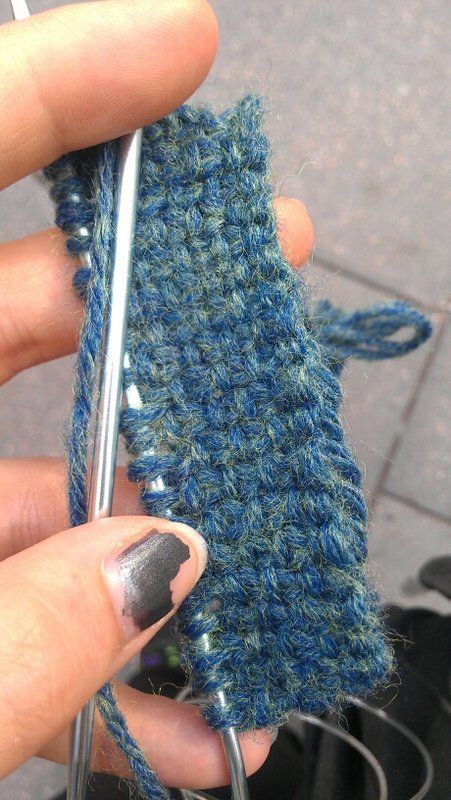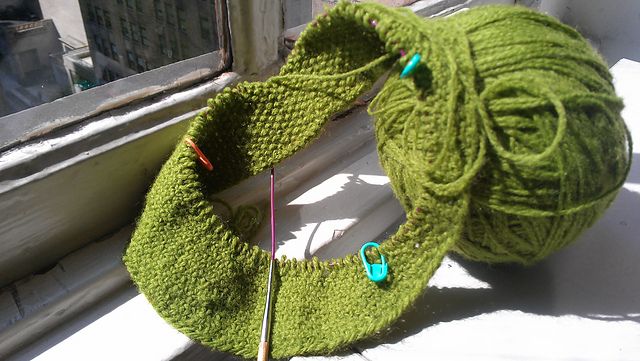
It’s a linen stitch, worked flat here across a 30ish stitch swatch, tho the pattern is written with an odd number in the round. (There are purl-side instructions for the short row sections, I just followed those.)
I am in love.
But that aside, it made me think about the ways in which I learn. By preference, I have never been the sort to just dive in and get my hands dirty to learn to do something. I find it wasteful. (Actually, that’s why I don’t like swatching to begin with, even if rationally I know it’s not wasteful, but that’s a whole other debate.) I like to have a conceptual understanding of what I am trying to do before I do it... and though I don’t always meet instant success, generally I do better if I have it than if I don’t. I need to grok it first.
Which brings me back to the linen stitch. (Linen stitch. This is a swatch of maybe an inch knit in old, not terribly soft acrylic, but I like it so much I want to rub my face all over it. Hnnngh. Sorry. What were we talking about?) I’d never encountered this stitch til I bought this book (as a side note, I also love this book so much I want to rub my face all over it, and the pattern I’m toying with is the fabulous hat on the cover,) but the basic building block that makes it go is something I’ve encountered before in pattern reading: slipped stitches.
Seriously what the hell is with slipped stitches?
I have been trying to wrap my mind around the idea, mainly in the context of slipped stitch or mosaic colorwork, and I never could get it. I mean, I think I understand the procedure, but not the why? (This is the exact opposite of my problems with calculus, where I could understand the concept perfectly but could never manage to do the math. My teacher was encouraging because the conceptual part was the “hard” part. I was inconsolable because I had never gotten grades that terrible in my life.)
As I understand mosaic knitting, you knit across a row with one color at a time, knitting the stitches that should be color 1 and slipping the color 2s, then knit across again with color 2, slipping the stitches you just did and knitting the ones you slipped last time. Okay. I think I see how that would make the pattern, but why? Is it just that it’s easier to handle one ball of yarn at a time? On the reverse side, wouldn’t it look the same as fair-isle style work with the floats hanging around in back? (This is something I try like mad to avoid in colorwork, so I don’t see the appeal. I twist on every stitch even if I’m not changing colors. I like the thickness of the fabric it creates, I like the look of the wrong side, and I like that I’m less likely to catch my scarf on everything around me.)
The linen stitch made a little more sense to me, because all the carrying of yarn for slipped stitches takes place on the right side of the fabric. It’s a little like seed stitch, but smoother, with minute floats across the front instead of purls. It looks pretty. It feels lovely. It makes sense, even if it takes twice as long to knit a row, or at least feels that way. (Since you’re knitting or purling the slipped stitches on alternate passes the length doesn’t increase as quickly as my hands want it to.) Hooray for slipping stitches!
That said... I still don’t understand the advantage for colorwork.
Which maybe means it’s time to accept I won’t grok it any better ‘til I get my hands dirty. Hmn.
At any rate, my plans for my next project had been up in the air-- either the Shipwreck shawl I’ve been yarn-hoarding for for literal years now, or the big gray and green checkered blanket that this Billow I bought on a lark wants to be. (Possibly it wants a few skeins more to go with it. I want a big damn blanket. I should see how I feel about knitting it, though, and how far a skein goes, before I invest tons more.)
All that said... every time I looked at this linen stitch, with its charming texture....
well.

The yarn is totally wrong and the gauge feels insane (though the circumference doesn’t seem unreasonable) but I’m going to soldier on a while and see if I can swing it.
No comments:
Post a Comment